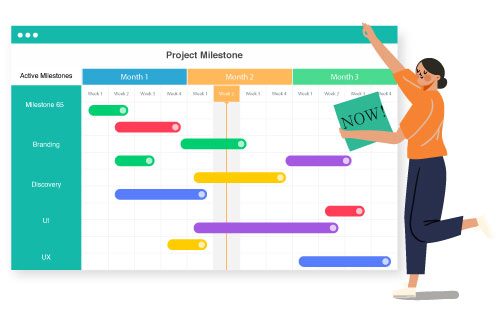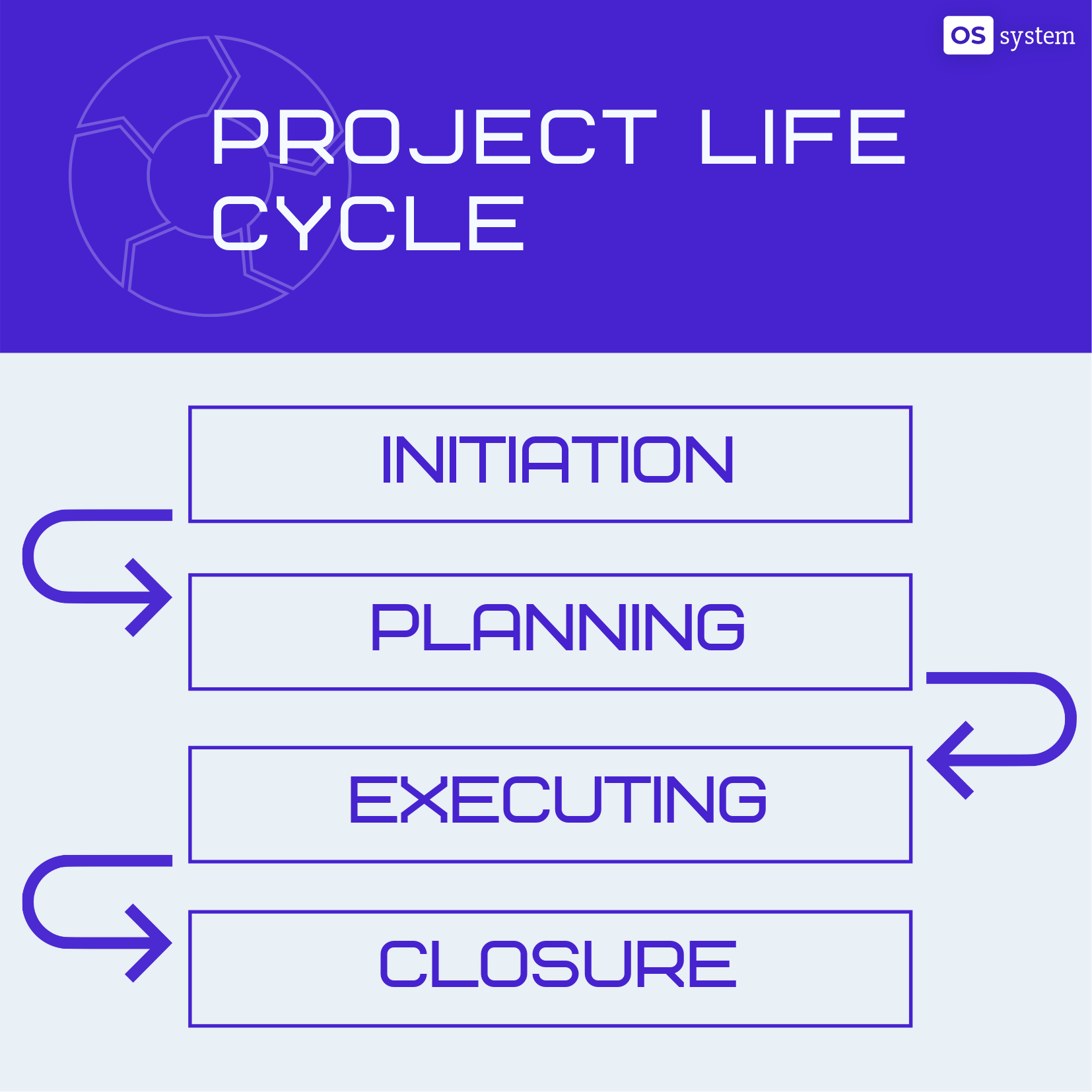Software Development Milestones
Read this article to understand what project milestones are, whether or not you need to make one for your project, when do you need project milestones and if every project needs a set of milestones or is it only necessary for some.
It’s very important to define clear objectives and milestones, according to PMI almost 37% of software development projects go wrong because of the lack of the same. A milestone is used as a progress tracker, we’ll get an understanding of the essential milestones every project should have.
What are development milestones in a software project?
A project’s progress toward its end aim is tracked using milestones, which are defined points in time over the project’s lifespan. Failure to meet a milestone indicates that a project is not developing as intended, and management is usually prompted to take corrective action. These anchors might include project start and finish dates, as well as the need for external review or feedback, as well as financial audits.

Milestone vs Task: Key differences
Tasks and milestones are very distinct, a task is something that has to be done or accomplished, whereas a milestone is a target that has to be attained by performing tasks.
A milestone can be considered as an equivalent to a goal or a target that has to be achieved for a list of tasks. In simple words, the task is the journey and the milestone is the destination. A task is accomplished over a period of time, but a milestone has no start or end, i.e. it has no time span.
Tasks and milestones work together to ensure that every single job is finished and the target milestone is attained. Understand how a project will not be able to meet its objectives if it does not have a proper plan in place. Tasks that aren’t useful to the project, its management, or its team members simply waste time. The objective is described by milestones, but the actions to get there are described by tasks. In project management software, there are a few more ways milestones differ from tasks:
- A distinguishing symbol, such as a diamond or a flag, is typically used to mark milestones on a Gantt chart.
- If jobs in the chain are delayed, dependent milestones are not immediately rescheduled. The dependency chain may be highlighted or a warning may be raised if a job in the dependency chain is rescheduled to begin or conclude after the milestone.
- An overview in project management software will help you to observe impending milestones as well as any scheduling concerns that can arise.
Gantt Chart: What is it?
One of the most prominent and effective methods of displaying jobs (tasks or events) abutting time is a Gantt chart, which is often used in project management.
Because it shows what work is anticipated for every day, a Gantt chart is important for project planning. It allows management and employees to see all of a project’s start, finish, and milestone dates in one layered bar diagram that is easy to understand.
A Gantt chart can help you with the following:
- You can see what are the various tasks that have to be performed
- You can see who are the people working on a task
- The start and finish timings for an activity can be seen
- The duration of an activity is shown on the chart
- Sometimes activities may clash with each other, the chart shows you which activities are clashing and when
- You can also see when a project begins and when it ends

Why are milestones important?
Milestones are only a method of organising and controlling time in a project. You may just have two milestones in a small project: the start and finish dates. Because the Agile Methodology emphasises fast revisions, fluctuating deadlines, and changing strategies, Agile projects have fewer milestones. The only milestones in an Agile project may come at the conclusion of each cycle.
Conventional project management systems that take a more formal approach to planning and scheduling are more likely to contain milestones.
Milestones are essential to project management success, we’ll now see why:
- With milestones in place, it gets easier to keep a check on project progress and deadlines
- Look for possible obstacles – most ventures depend on various teams or partners to complete tasks. Postponements and contraction are probable if these extrinsic elements aren’t monitored.
- Quickly identify essential dates – Utilizing milestones allows you to view the full picture and quickly identify key times and dates.
- Increases the project’s transparency – better transparency can make project management easier. If all the team members know how far along a project is done and how much work is left, it becomes easier to do work.
- Time and capital distribution – Utilizing milestones enables the management to allocate capital optimally so that projects are completed on schedule and in budget.
- Payouts to suppliers are frequently predicated on the achievement of specific milestones.
- Highlighting milestones that have been fulfilled on a frequent basis is a fantastic method to build confidence as well as to keep stakeholders informed about their contributions well before a project ends.
- Responsibility – development teams must be aware of their responsibilities. Milestones encourage everybody to take responsibility for their role.
- Gives you the ability to measure progress – it’s fantastic to be able to quantify your achievements! Meeting and fulfilling all of your important milestones is a rewarding and obvious approach to indicate a project’s successful implementation.
- You may simply shift aside from the task level and observe the actual growth extra vividly using milestones.

Work on a project without milestones
With a lack of milestones, management is just able to keep track of a slew of particular jobs. Task accomplishment is plainly crucial, however keeping work on schedule to assure effective, on-time delivery and meeting all targets requires a larger perspective.
Milestones are crucial to finishing a project on schedule and with the help of allocated resources.
In other words, in absence of milestones, no project or business can endure. But, with the lack of milestones, could any project get finished on schedule? That is a lot less likely. Milestones become critical to a team’s and project’s completion and a favourable outcome. They assist you in being responsible, staying on schedule, and completing tasks on schedule.
Milestones in Project
The strategic planning process is the first step of every project. Throughout that period, your group will collaborate with several other parties to conceptualise the purview of the project, as well as develop a project timeframe.
You can build project milestones after you’ve finished the first two stages – Identification of the purview of the project and establishing a time frame.
How to create project milestones
To establish project milestones, follow the steps below:
- Formulate a goal: ascertain a project’s requirements and how they will serve the end consumer.
- Disintegrate the project to make it simple: Polish up the latest project management advancements, then design and organise the project to keep a check on the progress. Organizing the project into several parts i.e. tasks and then dividing tasks into subtasks is the most efficient management strategy. This will make the whole process simple and efficient.
- Tasks should be assigned under milestones.
- Assignment of milestones: Project milestones can assist you in conveying what’s going on with the project in addition to making it possible to track advancement.
- Leverage existing frameworks to keep a record of milestones: Now that you have the milestones, it’s time to lay them out You may use a basic Excel Gantt chart template, any freely available software, or professional project management systems to monitor milestones.
- Hurdles should be identified and addressed: To move ahead, numerous initiatives depend on the contributions of extrinsic teams or collaborators. Recognizing obstacles throughout project implementation (e.g., personnel on lengthy leave, regulatory modification) and observing important pathways might assist.

Milestones for Project: How to choose and what to look for
It might be difficult to decide what to include as milestones in your own product development calendar. Very few milestones will not always give you enough project overview, while quite many milestones can clog up your timelines and limit overall usefulness.
It isn’t as straightforward as naming every delivery deadline to arrive at a middle ground. Project milestones must have clear and unambiguous meaning within and among projects.
You may not be sure about whether something is a milestone or not, for that asking the following things may help you:
- Whether it is a job that needs time or if it is a final product?
- Will it have an effect on the ultimate deadline?
- Is this a critical juncture in the project?
- Is it a good predictor of overall project progress?
- Is it necessary for stakeholders to examine and approve it?
- Is it an occurrence that has an influence on the project?
Once it comes to finalising project milestones, there are a few factors to bear in mind. To keep on schedule and on task, you must keep an eye out for each of the following:
- Dependencies: Whenever any of your team members or your smaller teams are reliant on some other team, there’s a possibility of conflict. It’s a situation where there’s a risk of a handover delay, which implies the subsequent team or person will be unable to perform the work that they have been assigned.
- Delays beyond your Control: Whenever we discuss delays beyond your direct influence, we’re referring to issues with obtaining supplies or other items from external suppliers. These kinds of problems can arise for a variety of reasons, and they can happen at any moment throughout the project’s setup and execution. Every one of these factors must be taken into consideration when creating the milestones.
- Delays because of the staff: These are disruptions that occur inside your team. This might include issues like someone falling ill or your staff refusing to work. There will always be certain issues inside the team that you cannot control, still, you can design reserves to cope with them.

- Unanticipated Requirements: You may begin working on your project only to realise that more resources are needed that you did not anticipate. All of these unanticipated requirements will have an impact on your capacity to meet the goals you’ve established, necessitating the addition of extra space.
- Client Requests for Adjustments: It’s inevitable that your client may make changes while you’re in the middle of a project and have made significant progress. In this case you should make it crystal clear to the client about the changes that their adjustments will bring about.
- Prolonged timelines: Your staff will offer you with timetables and estimations for just how long particular components of the project will require. Provide some extra time for every task so you’re not caught off guard if things don’t go as planned.
Major Project Milestones
There are 4 stages in the life of a project, i.e. inception, planning, implementation and closure. These four stages must be identified with the use of project management milestones.
For milestones to be relevant to your project, they must be set up in the proper order and clearly explained.
The best approach to show how milestones are used in project management is to understand with examples. Consider the following examples of common project milestones at various stages in a project’s life cycle:
Initiation
The first step of the project management life cycle is project inception, during which firms determine whether a project is required and how valuable it will be to them. Project milestones that may be included in the inception phase include:
- Gathering of requirements
- Validation of expectations for the requirements.
- Approval of the Project
Planning
The planning phase is the most important part of the project lifecycle since it instructs stakeholders about where as well as how a project will be carried out. The project plans are documented, the intended outcomes and requirements are specified, and the time line is developed during the preliminary stages. Project milestones may be included in the planning phase:
- Planning ahead of time
- Obtaining approval for your project proposal
- Identifying the beginning and conclusion of project stages
- Putting together a project team

Executing
You’ll be ready to begin the execution stage, the third stage of the project management life cycle, once you’ve thoroughly designed it. The project plan is put into effect during the execution phase. Project milestones that may be included in the execution stage include:
- Kick-off briefing for the project
- Confirmation of the Design
- Execution of the project (development)
- Testing for quality control
- Acceptance testing for users
- Rollout
- Assistance
Closure
The project life cycle’s final procedure is referred to as this. The project is officially closed at this point, and a report on the ultimate effectiveness of the finished project is delivered to the client. Project milestones that may be included in the closing phase include:
- Pass all deliverables to the client in writing
- Paperwork is handed up to the owners.
- Verification of the completion
- Examine all contracts and paperwork.
- Funds should be released.
How many milestones should there be in the project
There might be 10 or 200 tasks based on the timeframe of your milestone, project goal, and number of members in the team. Add as many as you need as long as each job has a clear objective and adds to the milestone. To keep on track, make absolutely sure that each team member is assigned an equal amount of tasks.
Minimizing Project Risks
Since each project is different, there may be extra milestones to take into account for yours. The milestones listed above are a decent approximation of what you’ll have to bring your project to fruition. Assess all these in context of your particular project objectives to help reduce the likelihood of a project halt or failure and maintain your project on schedule.
To begin your company project, you must first comprehend the discovery phase, that is an essential step in the pre – development process.
Read more about what the discovery phase is: “Discovery Phase: Why You Need It?”
Conclusion
Whenever it comes right down to it, project milestones keep the development cycle moving forward. They assist you in achieving your objectives and delivering the final outcome to your client. Milestones help you understand whether you are doing the right things and if you are doing those things on time . However, being ready for issues along the way is also essential. You and your team will be more prepared all around if you know how to set up and plan for milestones. You can reach out to us by filling the feedback form if you face any issues while setting up milestones for your own project, our experts will be more than happy to help you out. Just describe your project in detail and we will support you by giving you appropriate examples or directly help you design milestones for your project.

Subscribe to us










